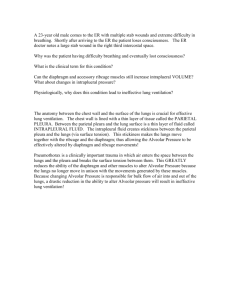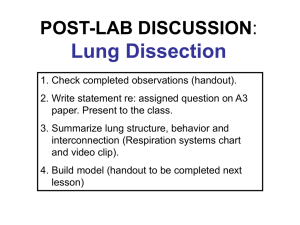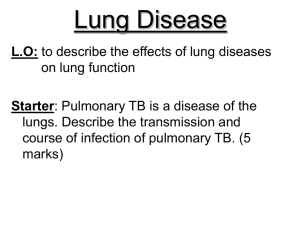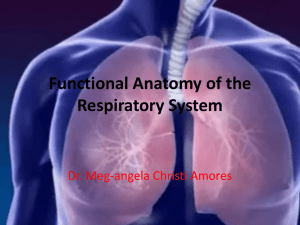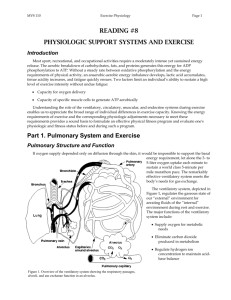Ch21
advertisement
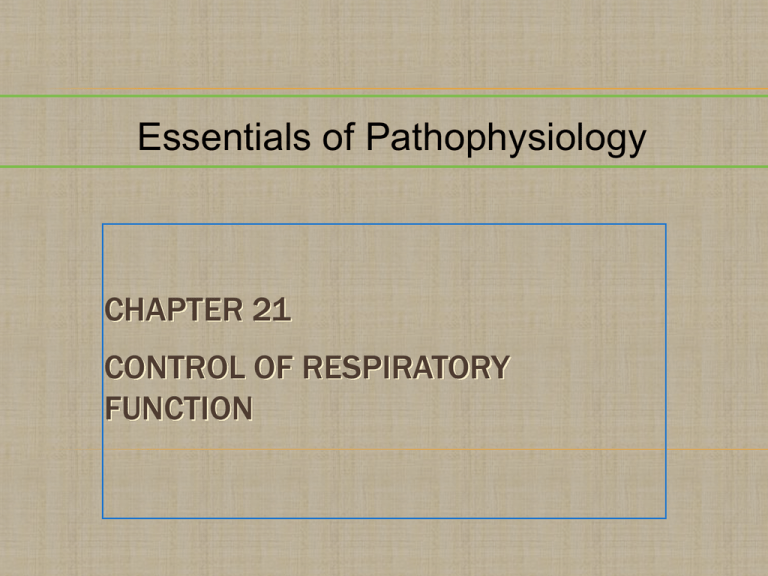
Essentials of Pathophysiology CHAPTER 21 CONTROL OF RESPIRATORY FUNCTION PRE LECTURE QUIZ F F T T T Pulmonary ventilation is the movement of blood through the lungs. Deoxygenated blood leaves the right heart through the pulmonary veins. The peripheral chemoreceptors monitor arterial oxygen levels and will stimulate respirations when the PO2 has dropped below 60 mm Hg. Lung compliance refers to the ease with which the lungs can be inflated. The effects of airway resistance on airflow can be illustrated by using Poiseuille’s law, which states that resistance to flow is inversely related to the fourth power of the radius. PRE LECTURE QUIZ Diffusion __________ exerts very important effects on lung inflation, including lowering the surface tension, increasing lung compliance and ease of inflation, and assisting in preventing pulmonary edema by keeping the alveoli dry. The relation between the oxygen carried in combination with hemoglobin and the PO2 of the blood can be described using the oxygen–hemoglobin __________ curve. The most important chemoreceptors for sensing changes in blood carbon dioxide content are the __________ chemoreceptors. __________ refers to the movement of gases in the alveoli and across the alveolar–capillary membrane. The blood vessels in the pulmonary circulation undergo marked ________________ when they are exposed to hypoxia. dissociation peripherial Surfactant Vasoconstriction LUNG FUNCTIONS Gas exchange Moves O2 into blood Removes CO2 from blood Blood storage Regulate vasoconstricting substances formed locally in injured tissue, acts in vasodilation of small Bradykinin- arterioles, is considered to play a part in inflammatory processes Angiotensin II Heparin- sulfuric acid ester that occurs especially in the liver and lungs, that prolongs the clotting time of blood by preventing the formation of fibrin obtained from the liver and lungs of domesticated food animals protamine sulfate- is a heparin antagonist CONDUCTING AIRWAYS Move air into lungs Warm and humidify air Trap inhaled particles (Mucus escalator) CONDUCTING & RESPIRATORY AIRWAYS Note Change of Cell Type & Thinning of Air to Blood Distance MEMBRANES AND CAVITIES Parietal pleura Visceral pleura Pleural space (between pleurae) Mediastinum RESPIRATORY AIRWAYS Bronchioles Alveoli Gas is exchanged with the blood QUESTION Which serous membrane lines the thoracic cavity? a. Viscera pleura b. Parietal pleura c. Visceral mediastinum d. Parietal mediastinum ANSWER Parietal pleura The organs and walls of the thoracic and abdominal cavities are covered with serous membranes. Visceral membranes cover the organ; parietal membranes line the cavity walls. The two membranes and the space between them allow for ease of movement. The thoracic cavity is lined by parietal pleura; the lungs are covered by visceral pleura. b. RESPIRATORY MUSCLES Diaphragm Accessory muscles of inhalation External intercostals Scalene Sternocleidomastoid Accessory muscles of exhalation Internal intercostals Abdominal muscles QUESTION Tell whether the following statement is true or false: During inhalation, the diaphragm contracts and flattens. ANSWER True The diaphragm is the main muscle of inhalation/inspiration. During inhalation, the diaphragm contracts and flattens (it moves downward in order to accommodate the volume of air you are taking in, allowing space for the lungs to expand). During exhalation, the diaphragm relaxes and moves back up. COMPLIANCE How easily lungs can be inflated depends on: Elastin Water and collagen fibers content Surface tension SURFACTANT REDUCES SURFACE TENSION SCENARIO: A man’s lungs were damaged during a fire He developed severe respiratory distress The doctor said smoke inhalation had caused an inflammation of his alveoli The damage had also destroyed some of his surfactant Question: What had happened to his lung compliance? Why was he given positive-pressure ventilation? LUNG VOLUMES Time LUNG CAPACITIES Vital capacity Inspiratory capacity Functional residual capacity Total lung capacity LUNG VOLUMES Tidal volume Inspiratory reserve Expiratory reserve Residual volume DYNAMIC LUNG FUNCTION Forced vital capacity Forced expiratory volume FEV1.0 Minute volume Maximum voluntary ventilation FORCED VITAL CAPACITY A B Volume diagram Flow diagram C MMEF =Mean Mid Expiratory Flow Matching: A Normal expiration B Obstructive expiration C Restricted Lungs QUESTION Which measure of lung function indicates the total amount of air that the lungs can hold? a. Tidal volume b. Functional residual capacity c. Vital capacity d. Total lung capacity ANSWER d. Total lung capacity is the maximum amount of air that the lungs can hold—everything (volumewise) at the end of a maximal inhalation (the deepest breath one can possibly take). Normal TLC is approximately 6 L. GAS EXCHANGE Oxygen moves from alveolar air into blood Carbon dioxide moves from blood into alveolar air VENTILATION AND PERFUSION Scenario: A child has inhaled a peanut, blocking her left primary bronchus. Question: How will the ventilation in her two lungs change? How will the composition of the air in her two lungs differ? Which lung should she send more blood to? How should her body alter perfusion of the lungs? VENTILATION–PERFUSION MISMATCHING Blood with no air Air with no Blood Air and blood In mismatch Blood goes to parts of the lung that do not have oxygen, and Blood does not go to parts of the lung that have oxygen In normal function blood perfusion is routed opposite of other body tissues. QUESTION Tell whether the following statement is true or false: Ventilation-perfusion mismatch results in hypoxia. ANSWER True In either case (ventilation without perfusion or perfusion without ventilation) oxygen is not picked up by the capillaries and delivered to the tissues. The result of decreased oxygen at the tissue level is termed hypoxia. BLOOD GASES—OXYGEN Dissolved oxygen = PaO2 or PO2 Normal value >80 mm Hg Oxygen bound to hemoglobin = oxyhemoglobin Normal value 95% to 97% saturation HEMOGLOBIN HOLDS 4 OXYGEN MOLECULES • How saturated is this molecule of hemoglobin? • How could a person have a hemoglobin saturation of 95%? Amount of oxygen the blood can hold What is the oxygen capacity of normal blood? What is the oxygen capacity of anemic blood? mg/dL mg/dL OXYGEN CAPACITY OXYGEN RELEASE If the blood released half of its oxygen to the tissues … How much oxygen would the normal tissues receive? How much would the anemic person's tissues receive? OXYGEN RELEASE (CONT.) Most body tissues have a PO2 of 40-60 mm Hg How much oxygen does the normal blood release at a PO2 of 40 mm Hg? The anemic blood? OXYGEN AFFINITY A B C PO2 Factors that shift the curve: CO2, pH, DPG, Fetal Hb How tightly the hemoglobin holds onto the oxygen Which of these hemoglobin samples has the highest oxygen affinity? Which will release the most oxygen to the tissues? BLOOD GASES—CARBON DIOXIDE Dissolved carbon dioxide = PaCO2 or PCO2 Normal value 35–45 mm Hg Carbon dioxide bound to hemoglobin = carbaminohemoglobin Carbonic acid bicarbonate ion and H+ When you exhale you remove CO2 from your blood and also decrease the amount of carbonic acid, raising your blood pH CO2 + H2O H2CO3 H+ + HCO3 QUESTION Tell whether the following statement is true or false: The relationship between PCO2 and pH is direct. ANSWER False The relationship is indirect. As PCO2 levels rise, the amount of carbonic acid in the blood increases, making the pH more acidic (decreasing it). CO2 + H2O H2CO3 H+ + HCO3pH= 𝑙𝑜𝑔 1 [𝐻 + ] Respiratory Control lungs inflate stretch receptors note increased lung volume pneumotaxic begins inspiration respiratory centers apneustic stretch receptors note decreased lung volume stops inspiration; begins exhalation lungs deflate CHEMORECEPTORS CAN ADJUST RESPIRATION RATE Central chemoreceptors Measure PCO2 and pH in cerebrospinal fluid Increase respiration when PCO2 increases or pH decreases Peripheral chemoreceptors Measure PO2 in arterial blood Increase respiration when PO2 <60 mm Hg SCENARIO You are caring for a COPD client… He has chronically high PCO2 He is being given low-flow oxygen and complains all the time that he “needs more air,” so you turn up his oxygen. Question: When you check on him later, he is unconscious and not breathing. What happened?
